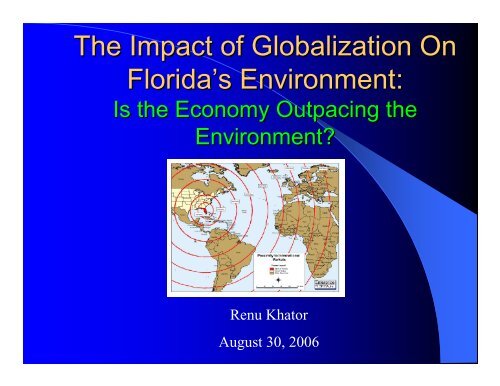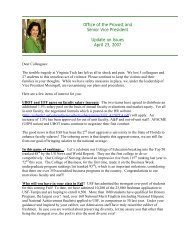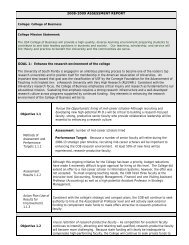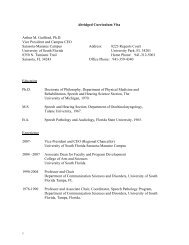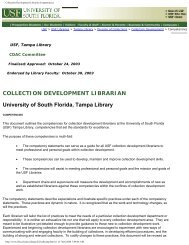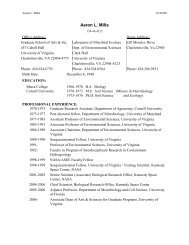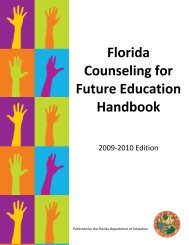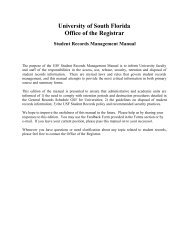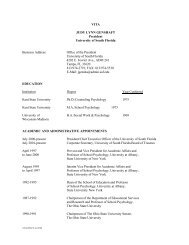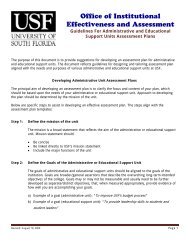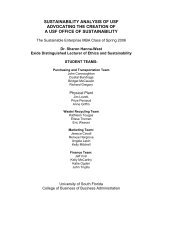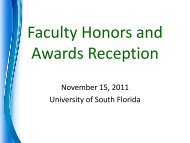The Impact of Globalization On Florida's Environment:
The Impact of Globalization On Florida's Environment:
The Impact of Globalization On Florida's Environment:
- No tags were found...
You also want an ePaper? Increase the reach of your titles
YUMPU automatically turns print PDFs into web optimized ePapers that Google loves.
TETRA Data ApplicationsTuomas KorpilahtiSolution Marketing ManagerEADS Secure Networks
<strong>Impact</strong> <strong>of</strong> <strong>Globalization</strong> on the<strong>Environment</strong>Progress paradigmSocieties, by nature, are constantly evolving andthat any change necessarily leads to adjustment,adaptation and thus progress
Incompatibility ParadigmCorporations are like cancerous tumors, whichforget they are part <strong>of</strong> a larger whole <strong>of</strong> thebody and unleash the pursuit <strong>of</strong> their unlimitedgrowth. With economic globalization, instead<strong>of</strong> trying to contain the cancer, we feed it –pulling down barriers in its path, allowing it todevour ever more <strong>of</strong> our natural world.Retallack
<strong>Globalization</strong> in Florida• International trade is the largest economicsector ($42 billion) more than tourism andagriculture!• 55% <strong>of</strong> US-Central America trade and 45%<strong>of</strong> the US-Caribbean trade moves throughFlorida seaports and airports• Florida exported goods worth $28 billionfrom 213 countries in 2000.
• Direct Foreign Investment in Florida isgrowing 16% annually• Florida’s is the second most attractivedestination for foreign travelers!• 300 people from other countries move toFlorida each day!
When it comes to movement<strong>of</strong> people, capital orproducts…Geography is History!!
International travel is up…Overnight trips to the US 1990-2000US Residents OvernightInternational Trips 1990-2000Source: US Department <strong>of</strong> Transportation, 2001
International phone calls havegrown…• <strong>The</strong> number <strong>of</strong> calls madefrom the United States toother countries increasedfrom 200 million in 1980to 6.6 billion in 2000.• <strong>On</strong> average, carriers billed$.51 per minute forinternational calls in 2000,a decline <strong>of</strong> more than60% since 1980.Millions <strong>of</strong>MinutesMillions <strong>of</strong> Minutes <strong>of</strong> International TelephoneCalls Originating in the United States30,00025,00020,00015,00010,0005,00001980 1985 1990 1995 2000YearSource: FCC, 2002
Value <strong>of</strong> US Trade withNAFTA PartnersValue <strong>of</strong> U.S. trade with NAFTA PartnersBillions <strong>of</strong> current $US70060050040030020010001988 1990 1992 1994 1996 1998 2000 2002YearSource: US Department <strong>of</strong> Transportation, 2001.
International InvestmentUS Direct Investment Abroad: 1994-2000Millions <strong>of</strong> dollars1,400,0001,200,0001,000,000800,000600,000400,000200,00001994 1995 1996 1997 1998 1999 2000YearSource: US Department <strong>of</strong> Transportation, 2001
International TravelInternational Visitors to FloridaNumber <strong>of</strong>Visitors (000)6200600058005600540052005000• Florida ranked #2in number <strong>of</strong>overseas visitors in200048001995 1996 1997 1998 1999 2000YearSource: Department <strong>of</strong> Commerce, International TradeAdministration
Foreign Direct InvestmentForeign Direct Investment (FDI) in Florida 1996-200140000350003000025000Millions <strong>of</strong>20000Dollars1500010000500001996 1997 1998 1999 2000 2001YearSource: Florida Enterprise, Inc., 2004.• Foreign Direct Investment(FDI) in Florida hasgrown 16% annuallybetween 1977-2000• <strong>The</strong>re were 1574 foreignestablishments related t<strong>of</strong>oreign direct investmentin Florida in 2000.Primary Data from: US Department <strong>of</strong>Commerce, Bureau <strong>of</strong> Economic Analysis
Florida ExportsFlorida’s export sales <strong>of</strong>merchandise in 2000Florida exported goodsworth $24.2 billion to213 foreign markets in2000Source: US Department <strong>of</strong> Commerce, International TradeAdministration, August 2001
Florida as an International• Seaports are criticalfor globalization• Florida is locatedwithin 2000 miles <strong>of</strong>an estimated 22different countries• Port <strong>of</strong> Miami, PortEverglades and PortCanaveral are theworld’s 3 busiest portsCrossroadSource: FDOT
Trade Agreements and Florida• Since the implementation <strong>of</strong> NAFTA exports to Canadaand Mexico have increased 38% (Trade PromotionAuthority).• Florida contributes more than 40% <strong>of</strong> US exports to theWestern Hemisphere (myflorida.com, 2003)• Florida’s 2000 export sales <strong>of</strong> merchandise is 65% abovethe 1993 total (US DOC, 2001)• 55% <strong>of</strong> trade between Central America and the US, 27% <strong>of</strong>US-S. American trade and 45% <strong>of</strong> US-Caribbean trademoves through Florida (myflorida.com, 2003)
Has there been a shift inProduction as a result <strong>of</strong><strong>Globalization</strong>?• “Florida has evolved from an agricultural stateinto a major international business and tradegateway between the Americas and the rest <strong>of</strong> theworld (“To diversify.., 2003)• Large Growth in Non-Farm Employment suggestsshift in production.• In a state once dominated by agriculture,especially citrus, the focus is now on high-techand service industries.
Change in Non-Farm Employment 1994-2004Change in Leisure and Hospitality Employment 1994-2004Source: US Dept. <strong>of</strong> Labor, BLS
<strong>Globalization</strong> and<strong>Environment</strong>An ad placed in Fortune Magazine by the Philippinegovernment read: “To attract companies likeyours…we have felled mountains, raized jungles,filled swamps, moved rivers, relocated towns…tomake it easier for you and your business to dobusiness here.”(Retallack, 2002, p. 16)
<strong>Impact</strong> on the <strong>Environment</strong>from Changes in Production• Agricultural Industry• Sugar Industry• High Tech Industry• Service Industry
Agriculture and Florida• 9 th nationally in value <strong>of</strong> farm products(2002) sales <strong>of</strong> $6.85 billion• 2 nd nationally in production <strong>of</strong> freshvegetables, $1.4 billion• Florida is the nation’s leader in citrusproduction with ~74% <strong>of</strong> US production in2002-2003.Source: Florida-Agriculture.com
<strong>Environment</strong>al <strong>Impact</strong>s <strong>of</strong>Agriculture• Agriculture is the highest consumer <strong>of</strong> water in FL(Council <strong>of</strong> 100).• Land and water development in the Everglades(EAA) has impacted wildlife and threatens the longterm economic stability <strong>of</strong> local economies.• Run<strong>of</strong>f from agriculture is suggested to be cause <strong>of</strong>Decline in coral reefs in South Florida.
Agricultural Industry and<strong>Globalization</strong>• Florida is experiencingincreased pressure to stayahead <strong>of</strong> globalcompetition– NAFTA has made it easierto import tomatoes fromMexico.– Average annual US tomatoimports from Mexico haveincreased 8-15% as a result<strong>of</strong> NAFTA’s tariff changes(Porter, 2003).• Increase in imports <strong>of</strong>agricultural products leadsto a decrease <strong>of</strong> used farmland in FloridaThousands <strong>of</strong>AcresFlorida Farm Land in Thousands <strong>of</strong>Acres (1963-2003)200001000001960 1970 1980 1990 2000 2010YearSource: Florida-Agriculture.com
<strong>Environment</strong>al <strong>Impact</strong>s <strong>of</strong> aShift Away from Agriculture• Decreased farm land use as a result <strong>of</strong><strong>Globalization</strong> leads to– Less pesticides and fertilizer– Less water usage• <strong>The</strong> reduction in agricultural activities could alsohave negative effects– <strong>The</strong>re may be increased land conversion to moreharmful non-farm uses (Aillery et al., 2001).
Sugar and Florida• Sugar Cane was valued at$517 Million in 2002(florida-agriculture.com)• Sugar is available fromforeign market at lowerprices, but is tariffedheavily and quotas preventimportation <strong>of</strong> sufficientamounts (Schwabach,2000).• High price <strong>of</strong> domesticsugar ensures high level <strong>of</strong>production.• Sugar threatens theEverglades• High levels <strong>of</strong>phosphorous presentpotential impact to Floraand Fauna• Plans are not sustainable,approximately 56 plantand animals species arethreatened or endangeredin the everglades (GCSF,2001).
<strong>Environment</strong>al <strong>Impact</strong>s <strong>of</strong> aShift away from SugarShift away from Sugar• “<strong>Globalization</strong> <strong>of</strong> trade, seen by someenvironmental activists as an undiluted evil isperhaps the only means to save Florida’sEverglades” (Schwabach, 2000).• A reduction in price, tariffs, or increased exportcould have positive effects on the environment.– A 10% reduction in domestic sugar price could increasethe water retention <strong>of</strong> the EAA by 10,000 acre-feet peryear over. This would occur primarily as a result <strong>of</strong>increased cropland retirement because it would nolonger be cost effective to produce sugar (Aillery et al,2001)
High-Tech in Florida• Key InformationTechnology (IT) industries– IT products and InformationServices– S<strong>of</strong>tware development– Modeling, Simulation,Training– Photonics, Lasers andOptics– Microelectronics– Telecommunications• High tech -the mostimportant source <strong>of</strong> futuregrowth in Florida• Employment has increased29.4% from 1995-2000.Growth <strong>of</strong> Employment in <strong>Florida's</strong> HighTech Industry 1995-2000#Employees4000003500003000002500002000001995 2000YearSource: RERC, 2002
Source: ESRI Business Analyst 1999; Dun & BradstreetSource: ESRI Business Analyst 1999; Dun & Bradstreet
High Tech and the<strong>Environment</strong>• Carries significant environment baggage as seenby Silicon Valley– Air, water pollutants• However, the Florida High-tech industry isrecognized as a “Clean Industry”– Subject to the CAA, CWA, CERCLA, Toxic SubstanceControl Act– <strong>The</strong> types <strong>of</strong> products being manufactured differ.• No signs <strong>of</strong> a reoccurrence <strong>of</strong> Silicon Valley inFlorida
Service Industry in Florida• More than 70% <strong>of</strong>Florida’s total economicoutput comes from serviceindustry• Sectors <strong>of</strong> the ServiceIndustry– Banking & Finance– Insurance– Legal Services– Accounting– Management, Consulting &Executive Search Firms• Expansion <strong>of</strong> the whitecollar service industry.• <strong>The</strong>re were 13 Fortune500 firms in Florida in1997– 11 were service orientedDistribution <strong>of</strong> Fortune 500 Firms in Florida ThroughIndustriesNumber <strong>of</strong>Fortune 500Firms121086420ServiceManufacturingIndustrySource: Hartshorn, 1997
<strong>The</strong> Service Industry and the<strong>Environment</strong>• Conducive to an environmentally friendlyeconomy• However,– <strong>The</strong> industry tends to increase human migrationand put additional stress on resources– Additionally, low-income jobs keepinfrastructure impoverished.
Summary <strong>of</strong> the Env. Effects<strong>of</strong> Changes in Production• Shift away from agriculture and sugar– Less land used– Less water– Less pesticides and fertilizers• Shift towards service and high-tech– <strong>Environment</strong>ally friendly economy– Migration creates additional stress on resourcesand infrastructure
Movement <strong>of</strong> People• <strong>Globalization</strong> impacts the movement <strong>of</strong>people through– Tourism– Migration• <strong>The</strong>re is an increased number <strong>of</strong> permanentinternational migrants, tourists and businessactivities (Solecki, 2001).
Tourism and Florida• Perceived as mostimportant industry inFlorida• Florida was the #2 USdestination forInternational Visitorsin 2000• Miami is the cruisecapital <strong>of</strong> the world, 3.6million passengers inFY 2002.• 15% <strong>of</strong> visitors to Disneyin 1990 were international• Employment from 1995-2000 has increased19.48%Growth <strong>of</strong> Employment in <strong>Florida's</strong>Tourism Industry 1995-2000#Employees4000003500003000002500001995 2000YearSource: Real Estate Research Consultants, 2002
Tourism and the <strong>Environment</strong>• “Nowhere is the destructive effect <strong>of</strong> tourism moreevident than in Florida” (Newman & Sage, 1999).– Increased consumption <strong>of</strong> energy: growth and tourismhave boosted the states energy consumption over 250%over the past 35 years (Hull, 2004).– Increased visitation leads to increased development aswell as to additional stress on natural resources• <strong>The</strong> UNEP has identified possible environmentaleffects <strong>of</strong> tourism as:– Overuse <strong>of</strong> water resources, pollution and degradation<strong>of</strong> fragile ecosystems (2001).
Population Growth• Domestic andInternational Migration• Florida’s population isexpected to grow morethan 53% from 2000-2030 (FDOT, 2003).Source: Enterprise Florida, 2004 (FL economy at a glance)
International Migration• 38.6% <strong>of</strong> Florida’s foreignborn population arrived inthe State after 1990 (FAIR2002 )– 12.9% <strong>of</strong> pop was foreignborn in 1990– Figure increased to 16.7%in 2000 (US Census, 2003)• In 2000, ~73% <strong>of</strong> theforeign born population <strong>of</strong>Florida was from LatinAmerica, 13% Europe and9% Asia (US CensusBureau, 2003)
<strong>Impact</strong> on the <strong>Environment</strong>from Human Migration• Change in Landscape• Modes <strong>of</strong> Transportation• Availability <strong>of</strong> Water• Municipal and Solid Waste Production• Flora and Fauna
Changing LandscapeSource: United States Geologic Survey
Transportation: MotorVehicles in Florida• Over the last 2 decades the number <strong>of</strong> registered vehiclesin Fl has increased by 166% (Governor’s Commission forSustainable Florida, 1995).• Roadway length increases at a rate <strong>of</strong> .7%/year (FDOT,2003)• Overall, emissions are down slightly (FDOT, 2003)Source: FDOT, 2003.
Enplanements for MajorFlorida Airports (1966-1999)1999)YearOrlandoMiamiTampa/St.Pete.196630308325753379295591970486201360723414220221975147585946832692290901198031245688136235360073019854848771771768540099791989737344985919364409261199912539000127210006912208Source: Bureau <strong>of</strong> Transportation Statistics
Urban Sprawl in Florida• Growth and urbanization result in reducedgroundwater recharge lowered groundwater tablesand increased pollution (GCSF, 2001)• Million <strong>of</strong> acres <strong>of</strong> Southern Forests will be lost tourban sprawl over the next 20 years– Florida leads the south in the amount <strong>of</strong> Timberlandlost to development (Pittman, 2001)– 20% <strong>of</strong> Florida forests have been lost from 1950-1990s• New highways, driveways and fairways consume1000 acres <strong>of</strong> wetland every year (Grunwald,2002)
Availability and Quality <strong>of</strong>Water• Urbanization and migration are stressing the groundwater,lowering the water table and increasing water pollution inthe state (Governor’s Commission for a SustainableFlorida, 2001).• A study conducted on the Indian River Lagoon Watershedconcluded that urbanization from 1920-1990 was thesingle most contributing factor in increased annual andsingle event run<strong>of</strong>f volumes (Kim et al, 2002).• Immigration between 1995 and 2000 increased the demandon water by approximately 30% (FAIR).
Municipal Waste ProductionSolid Waste Generation and Management 1995-199925,000,00020,000,000Tons <strong>of</strong> Waste15,000,00010,000,00019955,000,00019990TotalManagedTonsLandfilledTonsRecycledTonsSource: Florida Department <strong>of</strong> <strong>Environment</strong>al Protection
Flora and Fauna• Increased migration as a result <strong>of</strong><strong>Globalization</strong> may increase pest invasions.– Introductions from Asia to Florida increasedfrom 1986-2000– Increase in introductions parallels increase ingoods exported from China to the US (1985-$5b, 1999-$62b)(Loope & Howarth, 2002).• Urban and Rural development are 2 <strong>of</strong> theleading causes <strong>of</strong> loss <strong>of</strong> wetlands.
If <strong>Globalization</strong> is having annegative impact on theenvironment <strong>of</strong> Florida we wouldexpect….• A decline in air quality• A decline in water quality/availability• A decline in biodiversity• An increase in land usage• An increase in the production <strong>of</strong> waste• An increase in the consumption <strong>of</strong> resources
However, evidence shows…• Emissions havedeclined• Water quality isvariable• <strong>The</strong>re has been nosignificant change inthe status <strong>of</strong> Fauna inFlorida• Managed Solid wastehas decreasedEmissions inTons700,000600,000500,000Emissions in 400,000Tons 300,000200,000100,0000Annual Air Emissions CO2300,000,000.00200,000,000.00100,000,000.000.001995 2000YearAnnual Air Emissions <strong>of</strong> SO2 and NOx1985 1990 1995 2000YearSO2 TonsNox TonsSource: EPA
Can Florida’s<strong>Environment</strong> Keep Upwith the Stresses <strong>of</strong>Growth?
Policy ImplicationsPolicy Implications• <strong>The</strong> global economy in the post-NAFTA yearsmay not have adversely impacted the environmentto the extent hypothesized by the incompatibilityparadigm; nonetheless, the state faces many longterm environmental pressure points.– Farmers– Business– Manufacturers– Human migration– High Tech Industry– Service Industry
Are there Safeguards?• Global Safeguards– Collaborative Treaty frameworks– Self imposed by WTO or NAFTA• National Safeguards– National Policies and Laws• Local– 35 statutes governing environment– 11 Regional Planning Councils– Centralized agencies (FDEP)– Growth Management as a 1985 national model
Most Significant Hurdles to thePreservation <strong>of</strong> Florida’s• Subsidies– <strong>The</strong> sugar industry<strong>Environment</strong>– Encourages sub optimal land use• Growth Management• No protection against bio-invasion• No attention to the impact <strong>of</strong> global forces
Policy Recommendations• Need for Targeted Research• Need for Institutional Safeguards• Need for Reassessment <strong>of</strong> Existing<strong>Environment</strong>al Laws– Are existing laws sufficient?• Need for Engaging Local Communities• Need for Trained and Skilled Workforce


